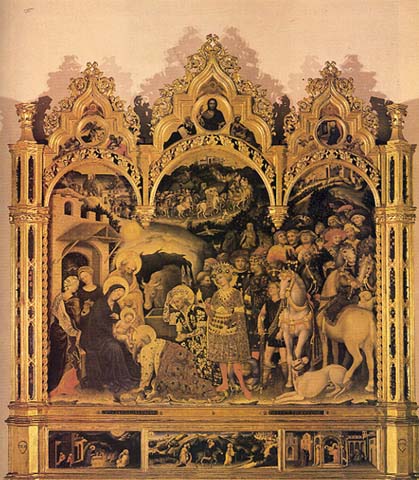Image Details

Editorial Photocolor Archives
Two full years (1421–3) were required to complete this panel painting, “Adoration of the Magi” by Gentile da Fabriano. The carved and gilded gothic frame makes the one large painting appear to be a triptych, a painting in three panels, which was a common 15th century altarpiece form. The central portion of the 9’ 10” x 9’ 3” painting illustrates Matthew’s account of the three magi or wise men who “saw the child with Mary his mother, and … fell down and worshipped him … [and] offered him gifts” (2:11). In the upper part of the picture, within the three arches of the frame, the artist has portrayed the various stages of the journey of the magi. In the first (left hand) arch of the gilded frame the three magi or wise men from the east stand on a promontory looking out over the sea to the guiding star. Within the center arch they go up to Jerusalem to look for the infant Jesus; in the arch on the right the procession of wise men approaches Bethlehem. The three small panels or predelle at the bottom of the painting further illustrate events during the infancy of Jesus. On the left the Nativity scene is represented in a starlit manger before the birth has been discovered. The middle panel depicts the flight into Egypt, by Jesus and his family. The third panel shows Jesus brought to the Temple in Jerusalem to be circumcised and named, as described in Luke’s account. The gothic structure representing the Temple in this panel shelters Mary, Joseph and Jesus, as well as the prophetess Anna (right) and Simeon (left) about whom Luke wrote in his account of this scene (2:26), “he should not see death before he had seen the Lord’s Christ.” Three red-winged seraphim hover above the three medallions in the frame. In the center medallion we see Jesus dressed in traditional red and blue. The Annunciation, as it is recounted in Luke, is represented by Gabriel, the annunciate angel on the left of Jesus, and by Mary, on the right. Six Old Testament figures, possibly representing Ezekial, Micah, Moses, David, Baruch and Isaiah are portrayed in segments bordering the medallions.
